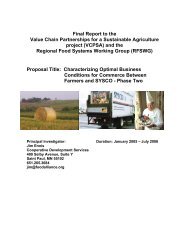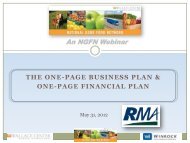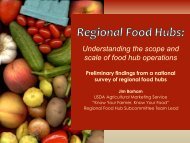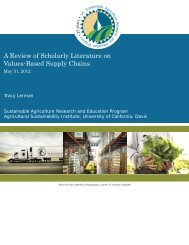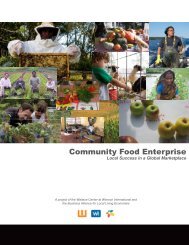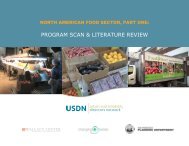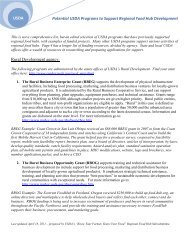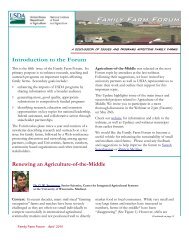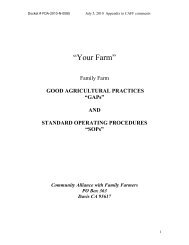The Common Market Feasibility Study - Agricultural Marketing Service
The Common Market Feasibility Study - Agricultural Marketing Service
The Common Market Feasibility Study - Agricultural Marketing Service
Create successful ePaper yourself
Turn your PDF publications into a flip-book with our unique Google optimized e-Paper software.
THE COMMON MARKET FEASIBILTY STUDYDemand Analysis38Respondents indicated a strong preference for local over organic with certain conditions. <strong>The</strong>re was astated preference meat and poultry that is pastured, raised without antibiotics and not produced onfactory farms. <strong>The</strong>re was also a stated preference for dry aged beef and for more goat products.Regarding pack and packaging responses varied depending on the type of business. For example,grocery stores and food co-ops had some interest in consumer or retail packs and frozen meat for resell.Restaurants had little or no interest in either and want freshly butchered meat. Institutional buyerswanted portion-packed meat (and dairy and produce in the case of the elder facility). Respondentsgenerally wanted product packed and graded to industry standards with caterers, coffee shops,restaurants, and institutions looking to minimize any excessive packaging and retail-oriented additions(i.e., PLU stickers on produce). Without exception, every respondent indicated they were either lookingfor the highest quality available or, in the case of the institutional respondents, the highest qualityavailable for the price they were paying.Demographics of Customers<strong>The</strong> customer base of prospective <strong>Common</strong> <strong>Market</strong> customers tended toward an educated, higherincome demographic, with the exception of the elder care facility (whose clients tended to be poor,inner-city residents). Restaurant clientele varied by business from “young, hip” (with racial and ethnicdiversity) to very high income. One caterer indicated a heavy tendency toward wealthy clientele.Coffee shops and food coops tended to reflect whatever ethnic and socio-economic demographicdiversity exists in the neighborhoods within which they are located. Grocers tend to serve clientele thatcan afford to shop at their stores.Barriers and Value ComponentsWhen asked rank the value of local, organic, conventionally produced farm products, respondents (withthe exception of the institutional respondents) valued locally produced first, with a slight preference forlocal organic or locally “responsibly produced.”With the exception of the institutional respondents, all indicated they purchased locally produced farmfoods. (<strong>The</strong> institutional respondents indicated, for example they purchased milk from Wawa howeverit is not verified that Wawa’s milk actually originates entirely from local dairy farms although it is alocally based business.) Locally produced products included: dairy, milk, yogurt, eggs, maple syrup,honey, produce, bread, tofu, sauerkraut, salsa, ice cream, meats, other bakery items, turkey, ham,bacon, and cheese.Respondents considered farm or producer identity important. All (with exception of the institutionalrespondents) were personally interested. Grocers and food co-ops felt it was important to theircustomers and would welcome any point of purchases (p.o.p.) material. Others stressed the importanceof farm and producer identity as a way of engaging their staff in the source of food they purchased.Barriers to purchasing more local product were consistent among respondents. All indicated a lack of agood distribution network, inconvenience, difficulty in procuring consistent supply and quality, inabilityto get everyday deliveries, lack of knowledge about what is produced and when it is available (and thetime constraint to find out), and seasonal limitations. <strong>The</strong>y only respondent who indicated that local



